 According to a recent poll on tourism in the
Caribbean, 68 percent of American travelers said they wanted to sightsee,
visiting historical sites and seeing the countryside, creating a complete
reversal of the American tourist stereotype of a "sun seeker." According to a recent poll on tourism in the
Caribbean, 68 percent of American travelers said they wanted to sightsee,
visiting historical sites and seeing the countryside, creating a complete
reversal of the American tourist stereotype of a "sun seeker."
For years, the Caribbean nations have fostered an image of
sun, sand, and sea with a dash of rum–only to their detriment. Though all
began as colonies of foreign powers, each island nation has developed a
unique culture in some cases known only to the locals and a few tourists,
who seek it out.
At same time, there had been a strong resistance among
island nations as a whole to the development of sites of historic and
cultural interest. This is because these sites haven’t been aggressively
promoted and also because they aren’t of top priority. But some island
nations, like Barbados, Grenada, St. Kitts/Nevis, and Antigua/Barbuda have
been doing something about it.
In the fall of 1989, Martin W. Beck, then partner in the
Barbados-based accounting firm of Ernst an Young, made a proposal at the
Caribbean Tourism Conference in Miami to create a "heritage ring"
by further developing nine prime historic sites. This was the result of a
feasibility study he had conducted of the sites for the Caribbean
Conservation Association, also of Barbados.
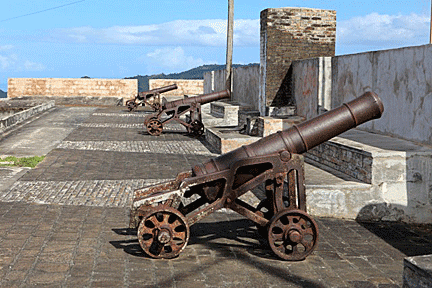 At that time, Beck said that it would take about $17
million over a period of five to ten years to prepare the nine sites, in
eight island nations, for tourism. This amount, he noted, was approximately
half of the price of a new 300-room hotel. None of the individual projects
would cost more than $3.5 million to develop. At that time, Beck said that it would take about $17
million over a period of five to ten years to prepare the nine sites, in
eight island nations, for tourism. This amount, he noted, was approximately
half of the price of a new 300-room hotel. None of the individual projects
would cost more than $3.5 million to develop.
The sites proposed were: Englilsh Harbor in Antigua; the
Garrison and Speightstown in Barbados; the Cabrits in Dominica; Fort George
in Grenada; Brimstone Hill in St. Kitts; Pigeon Island in St. Lucia; Fort
King George in Tobago and Fort Charlotte in St. Vincent.
Many are former military installations and garrisons with
commanding views of harbors and the sea. A few, such as Fort George in
Grenada, currently in use as a police station, have current uses that
detract from their sense of history.
Though the proposal, itself, died, it has made many of the
Caribbean nations more aware of the importance of their culture and history.
Beck pointed to the restoration of old San Juan as an
example of the success of developing the historic dimension of a
destination. Puerto Rico discovered just how financially successful it can
be to preserve and promote its historic sites.
Puerto Rico
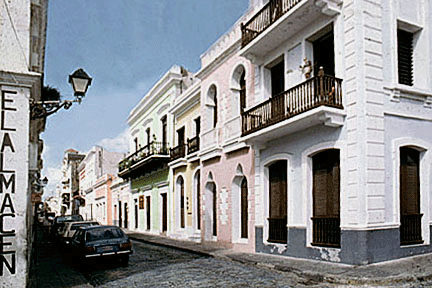 Puerto Rico was the pioneer in historic preservation. Beginning in 1955, its
government established Old San Juan, which was then a slum, as a historic
zone. In addition, it created the Institute of Puerto Rican culture and
granted a tax exemption to anyone who would restore their home or business
in the old city. Puerto Rico was the pioneer in historic preservation. Beginning in 1955, its
government established Old San Juan, which was then a slum, as a historic
zone. In addition, it created the Institute of Puerto Rican culture and
granted a tax exemption to anyone who would restore their home or business
in the old city.
While Puerto Rico, a Commonwealth of the United States,
has the advantage of being under the jurisdiction of the National Park
Service, the local government and private citizens are the ones who have
done the most to preserve the island's history.
In the seven-square-block area of the old city, more than
400 buildings have been restored in an ongoing effort. Restoration
architects captured the charm of old Spain in the narrow cobblestone streets
lined with exquisite Spanish colonial buildings painted in pastel colors.
Hanging balconies of dark wood or lacy wrought iron, sequestered inner
patios accessed through tall wooden doorways, fountains and gardens provide
a view of the city's past at every turn. All this, plus fascinating
boutiques and art galleries give the district a warm feeling that tourists
love.
At the same time, the National Park Service has fully
restored El Morro, the magnificent Spanish fortification that juts out into
the sea, as well as San Cristobal Fort in the northeast corner of Old San
Juan. In addition, there are a dozen museums within the old city plus at
least ten other historic sites, including the fascinating San Juan Cemetery.
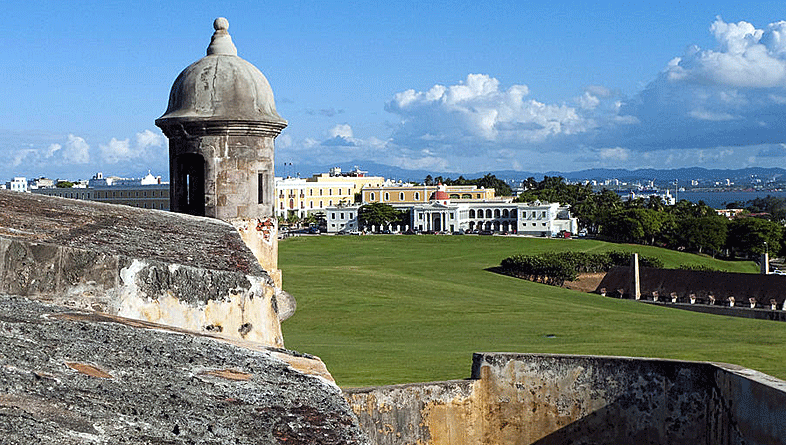
The Government of Puerto Rico has also restored the Paseo
de la Princesa esplanade to its original 19th century splendor. It has
created a new Museum of the Americas in the restored 19th-century Cuartel de
Ballaja, originally built as the headquarters of the Spanish army in the
Caribbean. This 200,000-square-foot museum houses exhibits tracing the
development of culture in the Americas from Alaska to Patagonia and from
prehistoric times to the present. Owners of many of the old haciendas have
restored them and some have turned them into romantic bed and breakfast
inns. Also, Ponce, Puerto Rico's second largest city, has been declared an
important historical zone and plans are to create other such zones
throughout the island.
Barbados
According to the Caribbean Conservation Association, Barbados has done more
with preservation than any of the other islands, second only to Puerto Rico.
The key to this success was the formation in 1961 of the Barbados National
Trust, modeled after the one in Britain.
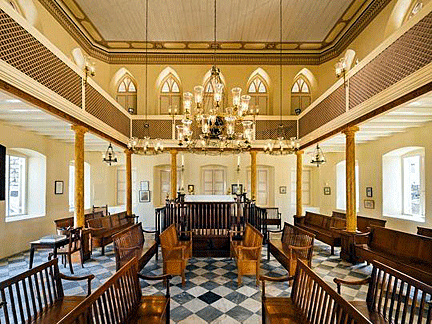 Since its inception, the National Trust has been
responsible for the restoration of nine historic sites on the island. The
town of St. Michael on Barbados now contains one of the finest national
museums in the Caribbean, housed in the old military prison of the British
garrisons. It traces the history of the island from prehistoric to modern
times. Since its inception, the National Trust has been
responsible for the restoration of nine historic sites on the island. The
town of St. Michael on Barbados now contains one of the finest national
museums in the Caribbean, housed in the old military prison of the British
garrisons. It traces the history of the island from prehistoric to modern
times.
On Sunday and Thursday evenings, the Barbados Museum hosts
a pageant, "1627 and All That Sort of Thing," which dramatizes the
island's history in the Bajan way, with music and dance. This brings the
historic site alive and makes it even more enticing to tourists.
One of Barbados’ newest restorations is the Bridgetown
Synagogue, whose congregation was established in 1654. The Jewish community
restored the current structure, built in the 1830's and surrounded by a
cemetery with gravestones dating to the 17th century. Five former great
houses of sugar plantations have also been restored by their owners.
Grenada
Another island nation that’s working hard to preserve its historic sites
is Grenada. The Parliament of Grenada passed legislation creating a National
Trust and an additional law putting stiff penalties on anyone harming any
historic sites or taking artifacts from them.
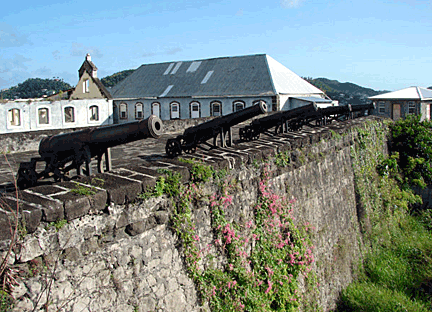 Three forts on the island, including Fort George, one of
the original nine sites of the Beck proposal, have been restored. Originally
built by the French and named Fort Louis, this strategic military
installation defending one of the best harbors in the Caribbean and Grenada’s
only fort, was overrun by the British and renamed Fort George. Three forts on the island, including Fort George, one of
the original nine sites of the Beck proposal, have been restored. Originally
built by the French and named Fort Louis, this strategic military
installation defending one of the best harbors in the Caribbean and Grenada’s
only fort, was overrun by the British and renamed Fort George.
The Canadian International Development Agency gave Fort
Frederick, built on a higher level of land to protect Fort George, a
significant facelift while an expert from Dominica worked with local
craftsmen to complete the interior. It now houses a small visitor center and
kiosks for selling local crafts. The third military installation, Fort
Matthew, formerly used as an insane asylum and damaged in the 1983 U.S.
intervention has yet to be restored.
Dominican Republic
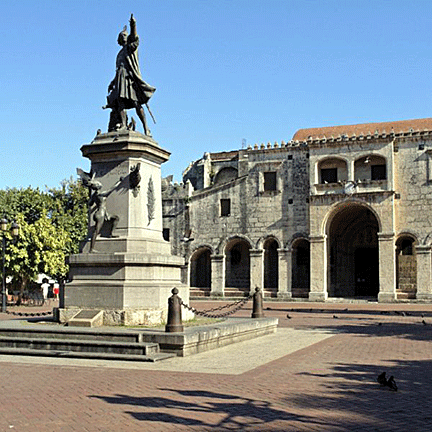 One of the Caribbean’s most extensive restorations is the old city of
Santo Domingo in the Dominican Republic. The Dominican government spent
millions of dollars restoring old buildings and rebuilding others from
existing plans and descriptions in anticipation of the 500th
anniversary of the first landing of Christopher Columbus. The restored
section of the old city is compact, and includes three main attractions–the
cathedral, the first in the New World and burial place of Columbus; the Casa
Reales, a former governor's palace now filled with artifacts, and the Casa
de Colon or Alcazar, the imposing house where Columbus' son Diego lived. One of the Caribbean’s most extensive restorations is the old city of
Santo Domingo in the Dominican Republic. The Dominican government spent
millions of dollars restoring old buildings and rebuilding others from
existing plans and descriptions in anticipation of the 500th
anniversary of the first landing of Christopher Columbus. The restored
section of the old city is compact, and includes three main attractions–the
cathedral, the first in the New World and burial place of Columbus; the Casa
Reales, a former governor's palace now filled with artifacts, and the Casa
de Colon or Alcazar, the imposing house where Columbus' son Diego lived.
Antigua
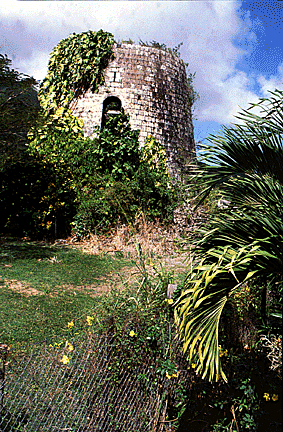 Besides English Harbour, the Caribbean base for Lord Nelson's fleet during
the Napoleonic Wars and another of the sites included in the Beck proposal,
the government of Antigua has restored Betty's Hope Estate. This plantation,
a superb example of the type prominent during the Caribbean sugar era of the
17th and 18th centuries, has been transformed into a "living
museum" and interpretative center for the sugar era, with
demonstrations of the early process of sugar cane and its conversion to
sugar and alcohol. Besides the main house, there are authentically restored
windmills, a boiling house, curing house, still, water cisterns, blacksmith
shop and quarry. Besides English Harbour, the Caribbean base for Lord Nelson's fleet during
the Napoleonic Wars and another of the sites included in the Beck proposal,
the government of Antigua has restored Betty's Hope Estate. This plantation,
a superb example of the type prominent during the Caribbean sugar era of the
17th and 18th centuries, has been transformed into a "living
museum" and interpretative center for the sugar era, with
demonstrations of the early process of sugar cane and its conversion to
sugar and alcohol. Besides the main house, there are authentically restored
windmills, a boiling house, curing house, still, water cisterns, blacksmith
shop and quarry.
Governor Keynell founded Betty's Hope in the late 1650's,
and in 1668, the King of England granted the estate to Christopher
Codrington, a planter from Barbados, who was the first to introduce
large-scale sugar cultivation to the Caribbean. For nearly 300 years, from
1685 to 1944, the Codrington family had an interest in Betty's Hope.
A spokesman for the Antigua government said the mill
restoration, originally to be completed by early 1991, will take a bit
longer than anticipated. At this time, visitors can explore the ruins of two
windmill towers and the walls and arches of the boiling house.
St. Eustatius and St. Kitts/Nevis
 St. Eustatius was the first of the island nations to have a Historic Core
Renovation Plan for restoring Upper Town, the oldest part of Oranjestad, its
main city. The Government of St. Eustatius found that Upper Town was
deteriorating and began an historic foundation campaign to do something
about it. This has made Oranjestad one of a few towns to be renovated on a
scheduled plan, which has become a model for the rest of the region. St. Eustatius was the first of the island nations to have a Historic Core
Renovation Plan for restoring Upper Town, the oldest part of Oranjestad, its
main city. The Government of St. Eustatius found that Upper Town was
deteriorating and began an historic foundation campaign to do something
about it. This has made Oranjestad one of a few towns to be renovated on a
scheduled plan, which has become a model for the rest of the region.
St. Kitts/Nevis is another island nation that has
developed a plan to beautify its main town. A group of interested citizens
and merchants established the Basseterre Beautiful Committee to come up with
a plan to restore the old wooden buildings in town and give a facelift to
other buildings without spending too much money. The group wanted to achieve
a more uniform historical look to the older buildings, many of which have
been modernized or added to in recent years.
To help a project like this, American Express inaugurated
a program of awards grants of $10,000 each, to be used as seed money, that
recognized excellence in the protection and enhancement of the Caribbean's
historic and architectural heritage.
Historical Museums in the Caribbean
A number of historical museums have opened in the Caribbean region. The
Cayman Islands opened its first national museum, modeled after the one on
Barbados, in the restored Old Courts Building in George Town, Grand Cayman.
Featuring 6,000 square feet of space housing exhibits covering Cayman
history and ecology, it also has a 30-seat audiovisual theater, a laser show
of various species of tropical fish, and several three-dimensional
bathometric maps.. Though smaller, it has tried to have the kind of quality
exhibits found in larger museums. While the exhibits are the latest in
high-tech, the exterior of the building resembles a simple Cayman-island
home with red roof, green shutters and white picket fence.
Another is the SIMARTN Museum in Philipsburg, Sint Maarten.
Housed in a restored 19th century West Indian home on Front Street, its
exhibits reflect the history and culture of the island and its people. This
is a multi-use museum, featuring periodic exhibitions in art, ecology, and
history.
Unfortunately, several obstacles have stood in the way of
developing a "heritage ring" in the Caribbean. Among these are the
lack of coordinated inter island transportation and the demands of competing
development projects. However, more and more islands will be joining the
historic preservation trend in the future as they see its benefits to
tourism.
< Back to
History Articles
Go to next History article > |
